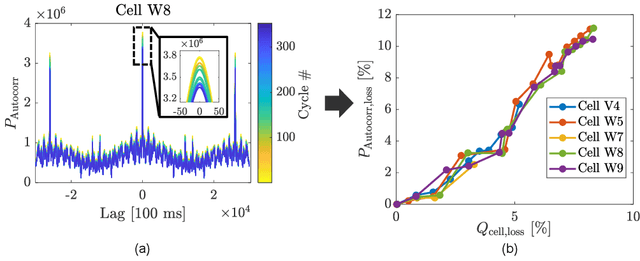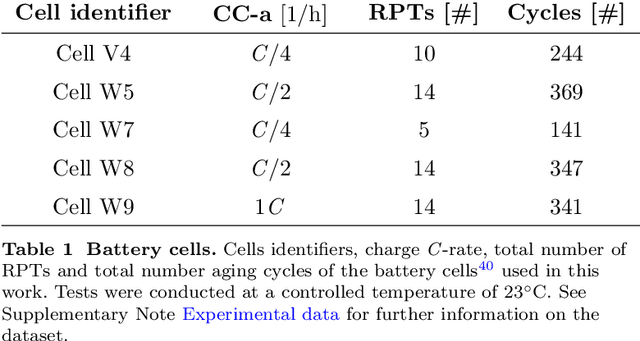Simona Onori
Onboard Health Estimation using Distribution of Relaxation Times for Lithium-ion Batteries
Oct 20, 2024Abstract:Real-life batteries tend to experience a range of operating conditions, and undergo degradation due to a combination of both calendar and cycling aging. Onboard health estimation models typically use cycling aging data only, and account for at most one operating condition e.g., temperature, which can limit the accuracy of the models for state-of-health (SOH) estimation. In this paper, we utilize electrochemical impedance spectroscopy (EIS) data from 5 calendar-aged and 17 cycling-aged cells to perform SOH estimation under various operating conditions. The EIS curves are deconvoluted using the distribution of relaxation times (DRT) technique to map them onto a function $\textbf{g}$ which consists of distinct timescales representing different resistances inside the cell. These DRT curves, $\textbf{g}$, are then used as inputs to a long short-term memory (LSTM)-based neural network model for SOH estimation. We validate the model performance by testing it on ten different test sets, and achieve an average RMSPE of 1.69% across these sets.
Domain knowledge-guided machine learning framework for state of health estimation in Lithium-ion batteries
Sep 22, 2024



Abstract:Accurate estimation of battery state of health is crucial for effective electric vehicle battery management. Here, we propose five health indicators that can be extracted online from real-world electric vehicle operation and develop a machine learning-based method to estimate the battery state of health. The proposed indicators provide physical insights into the energy and power fade of the battery and enable accurate capacity estimation even with partially missing data. Moreover, they can be computed for portions of the charging profile and real-world driving discharging conditions, facilitating real-time battery degradation estimation. The indicators are computed using experimental data from five cells aged under electric vehicle conditions, and a linear regression model is used to estimate the state of health. The results show that models trained with power autocorrelation and energy-based features achieve capacity estimation with maximum absolute percentage error within 1.5% to 2.5% .
Taking Second-life Batteries from Exhausted to Empowered using Experiments, Data Analysis, and Health Estimation
Feb 29, 2024Abstract:The reuse of retired electric vehicle (EV) batteries in electric grid energy storage emerges as a promising strategy to address environmental concerns and boost economic value. This study concentrates on devising health monitoring algorithms for retired batteries (BMS$_2$) deployed in grid storage applications. Over 15 months of testing, we compile, analyze, and publicly share a dataset of second-life (SL) batteries, implementing a cycling protocol simulating grid energy storage load profiles within a 3 V-4 V voltage window. Four machine learning-based health estimation models, relying on BMS$_2$ features and initial capacity, are developed and compared, with the selected model achieving a Mean Absolute Percentage Error (MAPE) below 2.3% on test data. Additionally, an adaptive online health estimation algorithm is proposed by integrating a clustering-based method, limiting estimation errors during online deployment. These results constitute an initial proof of concept, showcasing the feasibility of repurposing retired batteries for second-life applications. Based on obtained data and representative power demand, these SL batteries exhibit the potential, under specific conditions, for over a decade of grid energy storage use.
Second-life Lithium-ion batteries: A chemistry-agnostic and scalable health estimation algorithm
Mar 08, 2022



Abstract:Battery state of health is an essential metric for diagnosing battery degradation during testing and operation. While many unique measurements are possible in the design phase, for practical applications often only temperature, voltage and current sensing are accessible. This paper presents a novel combination of machine learning techniques to produce accurate predictions significantly faster than standard Gaussian processes. The data-driven approach uses feature generation with simple mathematics, feature filtering, and bagging, which is validated with publicly available aging datasets of more than 200 cells with slow and fast charging, across different cathode chemistries, and for various operating conditions. Based on multiple training-test partitions, average and median state of health prediction root mean square error (RMSE) is found to be less than 1.48% and 1.27%, respectively, with a limited amount of input data, showing the capability of the approach even when input data and time are limiting factors. The process developed in this paper has direct applicability to today's incumbent open challenge of assessing retired batteries on the basis of their residual health, and therefore nominal remaining useful life, to allow fast classification for second-life reutilization.
 Add to Chrome
Add to Chrome Add to Firefox
Add to Firefox Add to Edge
Add to Edge